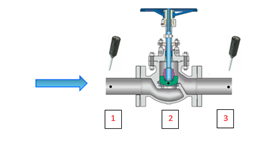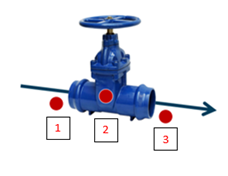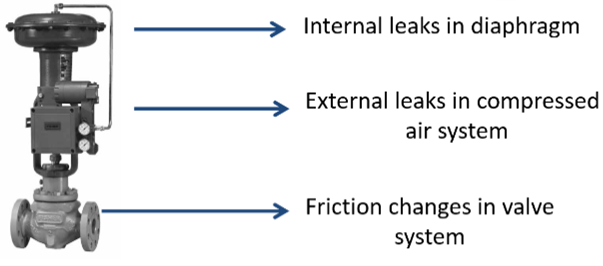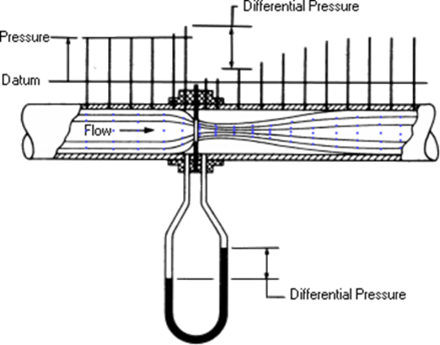In order to find out if a valve is working properly with ultrasound, measurements should be taken upstream of the valve, on the valve’s body and downstream of the valve. By following the below equation, it can easily be found out if the valve is fit for duty or not.
1=2=3: supposed tight 1>2>3: supposed tight 1<2<3: supposed leaking

(Note: measurements should be taken on the steel of the piping and not through the insulation in case of insulated pipes)
In case a series of similar valves have to be checked, it is possible to check them by comparing measurements as follows:
Check that the valve is closed (supposed tight), take a measurement upstream, on the body and downstream of the valve. Create a leak by slightly opening the valve until a leakage is noted and confirmed by the readings (as per the above method). Record the readings upstream, on the body and downstream of the valve. Then, check the remaining valves in the system by comparing them with your “standard” set of readings.

When assessing the condition of valves by comparing measures, it is important to remember that measurements should be taken in the same measurement location, with the same sensor and that the piping systems are the same. (Special care should be taken if a change of flow direction can take place in the system).
In a more advanced or sophisticated mode, the specialized UAS3 software allows to record and analyze the ultrasonic signals. Also routes, thresholds and alarms can be easily set up and all these will add to facilitating the monitoring process.

Typical valve set up, showing respectively the measuring points, dynamic signal record with values and the damage to the valve after the test indicated that the valve was leaking.
Other failure modes
There are three key elements to the valve: the actuator, the gasket and the valve body. Apart from leaking, valves may also suffer from other problems such as moving too slowly (plunger friction or stickiness), flutter & noisy valves, diaphragm leaks, gasket problems etc.
The actuator is quite probably going to be pneumatic operated, and both internal leaks (on the diaphragm) and external air leaks can easily be found. The gasket can be leaking, there can be mechanical problems on the plunger, such as friction or sticking, and there can be problems internally on the valve body itself. All these problems can generally be detected/checked by using ultrasound in the airborne or contact mode.
Cavitation & flashing valves

There are three key elements to the valve: the actuator, the gasket and the valve body. Apart from leaking, valves may also suffer from other problems such as moving too slowly (plunger friction or stickiness), flutter & noisy valves, diaphragm leaks, gasket problems etc.
The actuator is quite probably going to be pneumatic operated, and both internal leaks (on the diaphragm) and external air leaks can easily be found. The gasket can be leaking, there can be mechanical problems on the plunger, such as friction or sticking, and there can be problems internally on the valve body itself. All these problems can generally be detected/checked by using ultrasound in the airborne or contact mode.

Convincing evidence
On an FPSO (Floating Production Storage and Offloading) ship, a Chief engineer was facing problems with some of the vacuum valves and was on the point of ripping out an entire section at a cost of $125K. A test with ultrasound found a leaking vacuum valve within 30 minutes. After the test, there was no need for lengthy overhauls and replacement of a section. The only thing that was needed was correcting the leaking valve as the problem appeared to be a poor overhaul some years ago. Afterwards, the plant worked properly again and steam production was at an all-time high. Savings were estimated to be in range of $125K.
Whilst normal valve inspection is generally difficult and time consuming, an ultrasound check of a valve takes approximately one minute only!
Conclusions
This shows that the versatility of ultrasound can be extended to valve condition monitoring and help shipboard crew in avoiding outage, problems and accidents. Ultrasound technology does not only allow to check if a valve is leaking. By using the correct sensors and technique, different other valve related failure modes can be detected. From simple listening to more sophisticated valve condition monitoring by setting up routes, alarms, trending and analyzing static and dynamic signals, ultrasound allows you to set up a valve condition monitoring program that is tailored to your needs.



